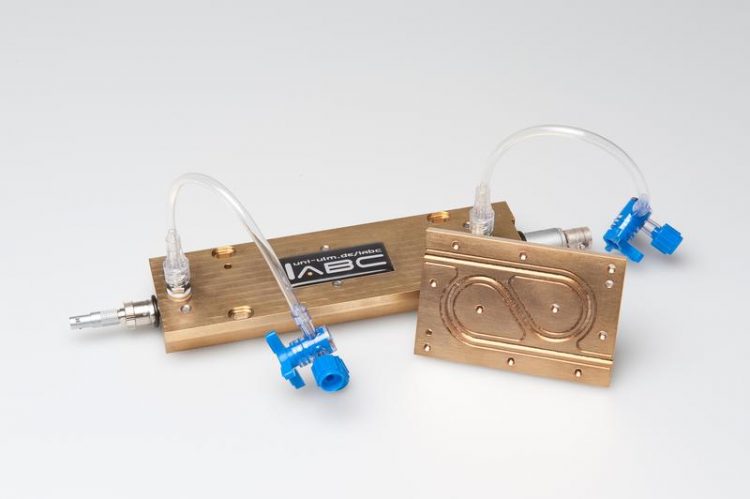What breath reveals: detecting diseases with infrared sensors / prestigious prize for chemists

Prof. Mizaikoff’s advanced breath diagnostic device Eberhardt/Ulm University
'The body's metabolism is reflected in the compounds present in the exhaled breath. On the basis of minuscule molecules, which are chemically altered or changed in presence or concentration in the case of physical disease, not only diseases of the lungs but also of the liver, the kidneys and even breast cancer can be diagnosed at – more or less – early stages,' Professor Boris Mizaikoff explains.
Because the low concentration of the trace gases requires highly sensitive instruments, breath gas analysis had been too expensive for the average medical practice – until now. In collaboration with specialised companies Mizaikoff currently develops a novel, cost-efficient method which can measure several trace gases simultaneously in small sample volumes. The so-called infrared spectroscopy takes place inside a hollow optical waveguide – developed by the IABC – into which the patient's exhaled breath is pumped.
In this mixture a frequency-tunable laser beam detects 'molecular fingerprints' of disease-specific biomarkers. The measured concentration of these markers might even make it possible to draw conclusions regarding the stage of a disease, as well as the treatment progress. Another advantage of μbreath:
The optical waveguides can be integrated into very small substrates, and in the future also into tiny chips, and are therefore much more versatile in their application. There is one current limitation: 'Changes in breath gas can also have non-pathological causes – due to diet for example. Therefore, to avoid measurement errors our sensor should be combined with an orthogonal analytical method in medical diagnostics for the time being,' Boris Mizaikoff says.
Ulm University offers an exceptional biomedical research environment for the optimisation of this non-invasive technology: at the collaborative trauma research centre 1149, for example, Mizaikoff’s team conducts sensor experiments in collaboration with the team around Professor Peter Radermacher, Director of the Institute of Anaesthesiologic Pathophysiology and Process Development at Ulm University Hospital.
'We were already able to demonstrate in the mouse model that it is possible to continuously monitor liver function with a μbreath analyser connected to a lung ventilator,' the chemist states. Moreover, relevant basics of lung physiology are being researched at the recently accredited graduate school PULMOSENS – and the fellows might quite possibly haul breath gas analysis into clinical application. A spin-off is certainly conceivable.
In fact, the novel technology is not limited to medical diagnostics but is also applied in environmental analytics. It all started as a collaboration with the Lawrence Livermore National Laboratory (LLNL, USA): the German-American scientists had been searching for a way to detect gaseous hazardous substances – and now their patented technology is the basis of breath gas diagnostics.
With the second prize of the 'Emerging Technology Competition' (category 'Health and Wellbeing'), hosted by the 'Royal Society of Chemistry', come valuable industry contacts, support for a potential spin-off by a global player, plus 3000 British pounds as reward for the research team around Professor Mizaikoff. The first prize went to the researchers of Scottish St. Andrews University.
'We never dreamed of receiving a prize for application-oriented technologies for a novel analytical method which we first published only three years ago in the journal “Analytical Chemistry”,' says the researcher from Ulm. The jury members are top-class representatives of the pharmaceutical industry, which suggests great potential for μbreath. 'The interest within industry is high: we already receive numerous enquiries regarding our breath gas analytics,' Professor Mizaikoff adds.
The measuring method is currently being refined under Mizaikoff’s leadership in the course of the 'Advanced Photonic Sensor Materials' project. The project is funded by the Federal Ministry of Education and Research (BMBF) as part of the programme M-ERA.NET. Highly specialised companies in Germany and Austria are involved alongside the Institute of Analytical and Bioanalytical Chemistry.
Further information: Prof. Dr. Boris Mizaikoff: +49 731 50-22750, boris.mizaikoff@uni-ulm.de
http://t1p.de/rcs-winners2016 Winners „Emerging Technologies Competition“
Media Contact
All latest news from the category: Awards Funding
Newest articles

A ‘language’ for ML models to predict nanopore properties
A large number of 2D materials like graphene can have nanopores – small holes formed by missing atoms through which foreign substances can pass. The properties of these nanopores dictate many…

Clinically validated, wearable ultrasound patch
… for continuous blood pressure monitoring. A team of researchers at the University of California San Diego has developed a new and improved wearable ultrasound patch for continuous and noninvasive…

A new puzzle piece for string theory research
Dr. Ksenia Fedosova from the Cluster of Excellence Mathematics Münster, along with an international research team, has proven a conjecture in string theory that physicists had proposed regarding certain equations….



